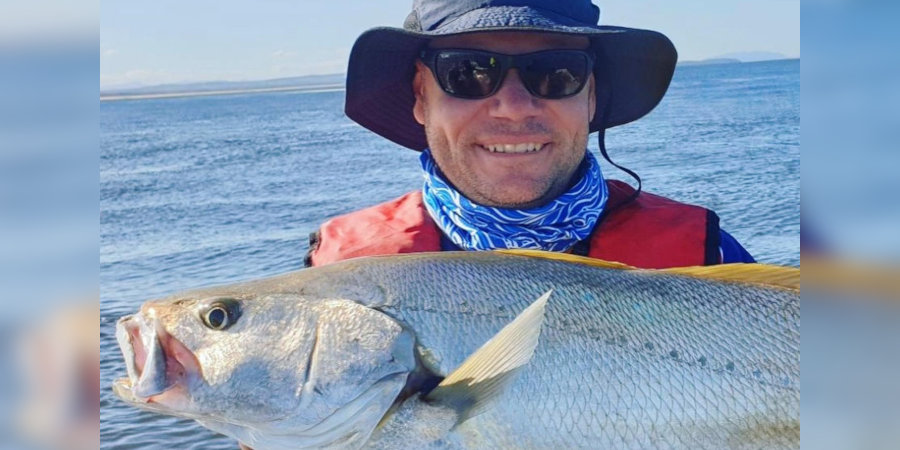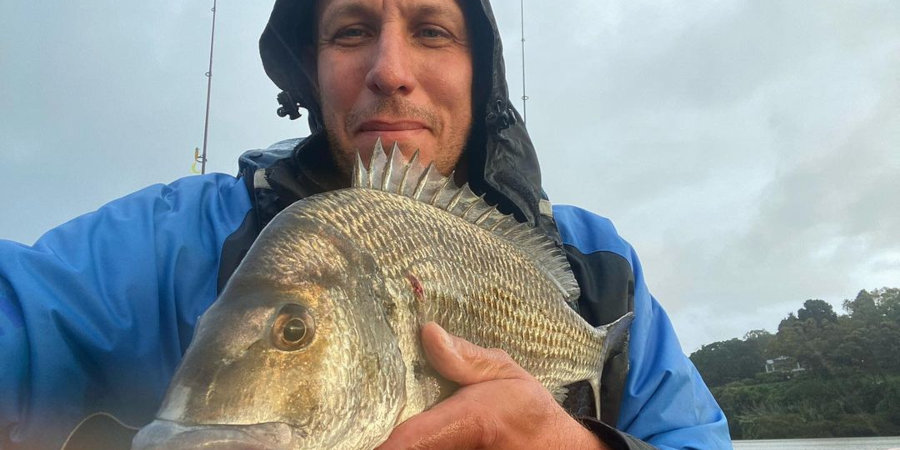
Tristan’s Tips For Ballina Headlands Jewfish
- Being an apex predator, jewfish don’t feed 24/7, tending to eat once or twice a day but eating large items during each feed. Identifying bite periods is therefore crucial when fishing the rocks and headlands.
- The period from Anzac Day onwards is traditionally the best time to fish. Smaller fish in the 5-10kg range can be caught all year round, but the 10-25kg models move from the offshore reefs to the headlands in late autumn through winter, following the mullet schools. Seeing increased activity among commercial mullet netters is a good indication that mullet and therefore jewfish are in town.
- The rockwalls fish well at this time of year too, but Tristan prefers to release most of his jewfish and finds that headlands make it easier to land a fish without using a gaff, allowing them to be released unharmed.
- To find the best headland fishing spots, look for structure that holds bait species such as mullet, tailor, bream and blackfish. Spend some time looking on Google Earth for areas where there are rock fingers, bommies, boulders, undercuts and other structures that break the swell and the current.
- Water depths of 1-2m are sufficient for jewfish to hunt and ideal places have sandy areas around the structure, with milky, turbulent water to provide cover.
- Tristan does most of his fishing for jewfish around dawn and dusk, particularly when these coincide with a tide change. However, fishing through the night can be productive provided the conditions are safe to do so and the angler has familiarised themselves before dark with the locations of slippery rocks, cracks, places to wash up fish and so on.
- Wear rock boots fitted with steel studs and a life vest. Tristan likes to wear a kayak life vest because it provides enough buoyancy to assist with staying afloat, but not so much that he can’t duck-dive beneath breaking swells.
- Watch the area you’ll be fishing for at least 15-20 minutes before starting, to judge how high the swell is coming – and remembering that a rising tide will cause the swell to increase while you’re fishing while a falling tide will cause the swell to fall over time.
- Be sure to identify places where fish can be safely washed up on rocks BEFORE you start fishing.
- Most headlands have six or so spots where jewfish can be caught, although some are obviously safer than others. Explore your chosen spots in daylight at low tide to understand how to access and safely fish it.
- “The biggest swell you can fish safely is the best swell”. Jewfish like atrocious conditions because swell and surge disorientate baitfish and make it easier for the jewfish to pick them off. A barometer of 1020, dark moon phase and tide change around dawn and dusk are also great.
- Tristan finds that he’ll catch a big fish 10-25kg about every ten trips. Sometimes he’ll get 3-4 in a session and other times he’ll have many sessions without a bigger fish. School jew are more reliable.
- A good headlamp with a red light is essential. Putting a white light on the water will usually cause the fish to stop biting, but red wavelengths don’t penetrate into the water so much and don’t affect the fish.
- Often jewfish will bump a lure without fully committing, so if you’re familiar with the area and know the locations of the obstructions you can tell of that bump was a fish or your lure hitting a rock.
- Time on the water is vital. Choose a small number of locations and visit them frequently to work out what ledges are productive on what tides. Keep a diary of your results, including the donut days.
- Usually after you set the hooks a jewfish will respond with a couple of violent headshakes followed by a long, fast run. Headlands jewfish tend to fight longer and harder than estuary fish due to the well oxygenated water that keeps them strong for longer. Fish with high rod angles to help keep the line out of bommies and cunje.
- Fighting a jewfish until it’s exhausted will cause it to float on the surface and make it easy to land by washing it up on a swell.
Tristan’s Jewfish Tackle
- A 9’ Atomic Shore spin rod (15-25lb) is great for throwing small lures when the swell is less than 1.5m, and also doubles for throwing metals for tailor. A Penn Spinfisher reel with a rod-length of 30lb mono or fluorocarbon leader.
- A 12’ Spin rod, Penn Spinfisher and 50lb braid is required for fishing bigger swells. Tristan prefers larger, nosier lures for these conditions. A rod length of 50lb mono leader helps with abrasion resistance and gives some shock absorption.
Tristans Headlands Jewfish Lures
- Mullet of 15-20 cm long have quite thick bodies, so matching that with hard body lures is a good strategy. Killalure Jewies, Leavy’s Lures and Halco’s all work, but they must be shallow running (2-3ft below the surface. These lures are cast long and worked very slowly, especially once the lure is getting close to the waters edge – it’s not uncommon to hook a fish just a rod length or two from the rocks. The bigger, thicker, rattling lures are best in a big swell and the slimmer, more subtle lures are good in a medium swell.
- A 103mm Squidgies Fish or a 5” ZMan Shad on a 1-2oz head is great, especially when the swell is low. The bigger the swell, the larger the head. These lurs can be cast long and then slow rolled back, no fancy techniques are required. Colour is not important, but white or black lures are good. Tristan likes to use dark colours in dark conditions and white as the day gets brighter.
- A swimbait is good if the conditions are calm and flat. Tristan has recently been using the Atomic Real Baits 130mm mullet, removing the bottom treble to reduce snagging. Cast out and slow roll them back.
Tristan Sloan
Fishing Writer And Rec Fishing Advocate
Tristan started fishing as a kid in the Ballina area, eventually writing for Fishing World and Fishing Monthly magazines. His passion for fishing led to his employment in a range of rec fishing advocacy, advisory and policy roles, much of it based in Darwin. These days he’s back in Ballina and targeting a species that started his fishing obsession – jewfish….
Tristan’s Sponsors

Mastering Land-based Mulloway Fishing In Botany Bay
Land-based fishing in Botany Bay can be more productive than many anglers would ever imagine. Local Gun Tom Munro explains how he’s figured out the local mulloway population and now consistently targets them on soft plastic lures.

Fishing At Forster: 5 Top Spots With Local Gun Luke Austin
The fishing at Forster – Tuncurry is superb, all year round with numerous options for land-based and boating anglers alike. Luke Austin has lived there all his life and shares some great spots for visiting anglers and locals alike.

Matt Poulos’ Georges River Fishing Secrets: Jewfish On Lures
This interview about Georges River Fishing is ALF EPISODE 642 Check out our Lure Fishing archives for more information on Botany Bay Fishing Spots and Jewfish Fishing Matthew Poulos High Tide Tours Matt is a Georges River fishing gun, having grown up tossing baits and...

The Five Best Fishing Spots In Sydney With Luke Kay
The greater Sydney area has no shortage of fishing opportunities for lure tossers, as today’s guest Luke Kay shares in this interview. From the bays and estuaries to the ocean rocks, Luke takes us through where he likes to go in search of fish.

Secrets To Lure Fishing In Lake Macquarie During Winter
EPISODE 630 Lake Macquarie lure fishing gun Dan Guilfoyle is back with advice on how to enjoy hot winter fishing in Lake Macquarie. Dan Guilfoyle Lake Macquarie Fishing Identity Dan grew up fishing Lake Macquarie and as a youngster used to walk the banks and wade the...

Episode 575: Jewfish Roundup With Greg Vinall
Greg has hosted the Australian Lure Fishing Podcast since the very first episode in January 2019, being the interviewer for every one of the first 500 episodes. When he’s not interviewing top notch lure fishers he’s making wooden lures, chasing northern estuary...

Episode 569: Lake Macquarie On Lures With Dan Guilfoyle. Part 1: Summer.
Lake Macquarie might cop a lot of fishing pressure over the summer months, but that doesn’t mean there aren’t some great opportunities on offer for those in the know about how, when and where to fish! Dan Guilfoyle shares a lifetime of local knowledge for those keen to hit the water in the coming months.

Mastering Land-based Mulloway Fishing In Botany Bay
Land-based fishing in Botany Bay can be more productive than many anglers would ever imagine. Local Gun Tom Munro explains how he’s figured out the local mulloway population and now consistently targets them on soft plastic lures.

Fishing At Forster: 5 Top Spots With Local Gun Luke Austin
The fishing at Forster – Tuncurry is superb, all year round with numerous options for land-based and boating anglers alike. Luke Austin has lived there all his life and shares some great spots for visiting anglers and locals alike.



0 Comments